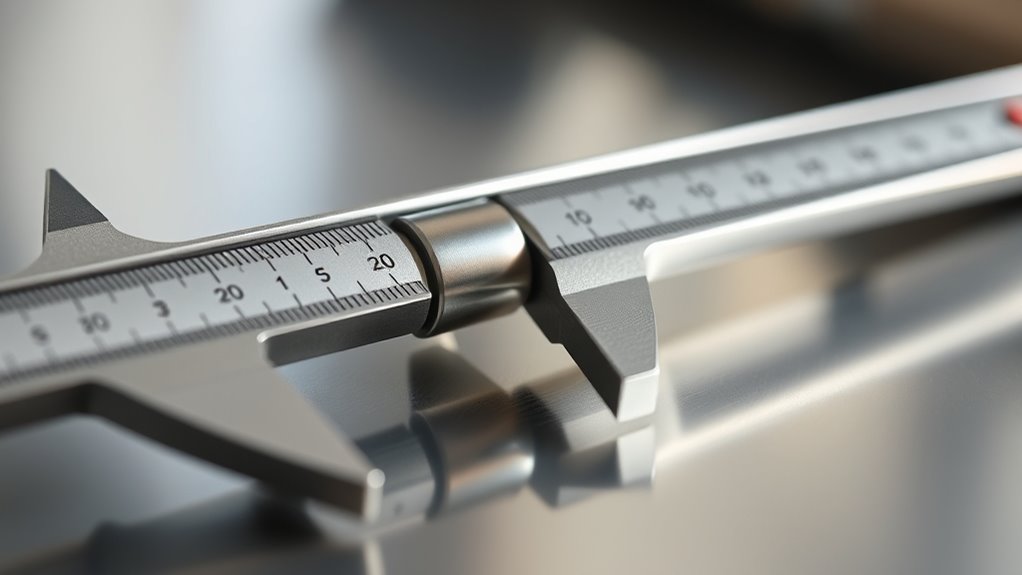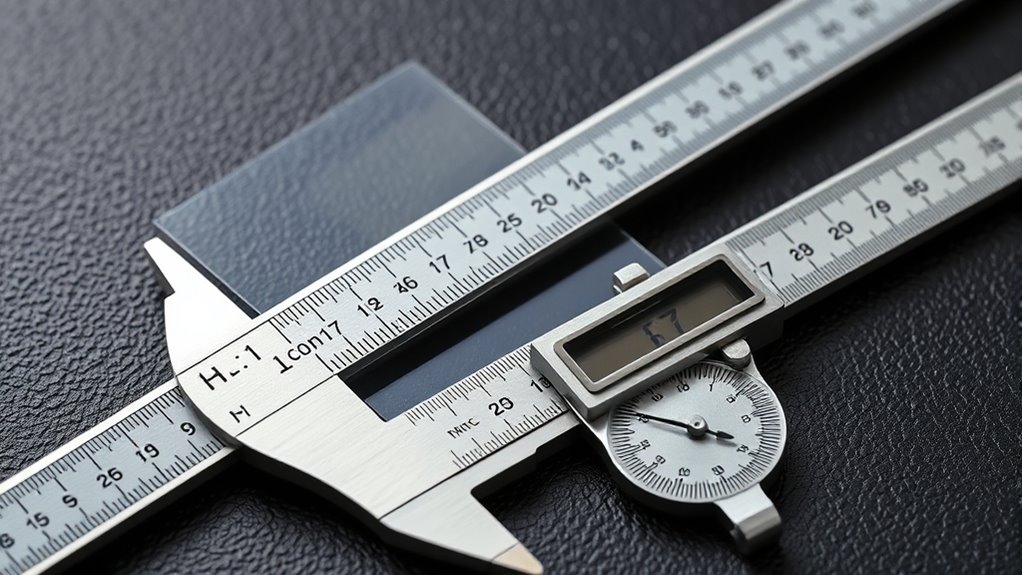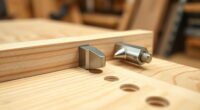Calipers and Verniers are essential tools for measuring thicknesses and diameters accurately. You can use digital or manual Verniers to obtain precise readings, ensuring parts fit perfectly. Always zero the device before measuring and compare your results against calibration standards for accuracy. Proper calibration helps prevent errors caused by wear or damage. Keep exploring further to discover how to maintain and perfect your measurement techniques for reliable results.
Key Takeaways
- Digital and vernier calipers measure thickness and diameters with high precision, suitable for detailed engineering tasks.
- Proper calibration ensures calipers provide accurate readings for consistent measurement of parts.
- Zeroing digital calipers before use guarantees measurement accuracy for thickness and diameter.
- Vernier calipers use sliding scales to measure internal, external dimensions, and depths precisely.
- Regular calibration and proper technique prevent measurement errors in thickness and diameter assessments.

Have you ever wondered how precise measurements are taken in engineering and manufacturing? It’s a critical aspect, ensuring that parts fit together perfectly and systems function reliably. When you’re working with tools like calipers and verniers, achieving measurement accuracy becomes a top priority. These tools are designed to provide detailed readings of thicknesses and diameters, but their effectiveness depends heavily on proper calibration techniques. Calibration is the process of adjusting or verifying the accuracy of your measuring instrument against a known standard. Without it, your measurements could be off, leading to costly errors or faulty products. Regular calibration helps maintain the precision of your calipers and verniers, ensuring consistent results over time.
Regular calibration of calipers and verniers ensures measurement accuracy and prevents costly errors.
To guarantee measurement accuracy, you need to understand and apply appropriate calibration techniques. For instance, most digital and dial calipers come with a standard calibration block or gauge. You start by closing the jaws completely and zeroing the device, which means aligning the reading to zero when the instrument is fully closed. If the reading isn’t zero, you’ll need to adjust or calibrate the device according to the manufacturer’s instructions. For vernier calipers, calibration might involve checking their readings against a gauge block of a known measurement. If discrepancies are detected, you’ll adjust the instrument or note the variance for correction during measurements. These calibration steps are essential to prevent errors from creeping into your readings and to maintain measurement accuracy. High precision is crucial for obtaining reliable measurements in technical applications.
In practice, calibration techniques can vary depending on the type of caliper or vernier you’re using. Digital calipers often have a zero button, making calibration straightforward, but manual tools require more careful adjustments. Regularly verifying your tools with calibration standards helps you detect wear or damage that could impact their precision. It’s also good practice to perform calibration at regular intervals, especially if you’re using the instruments frequently or in demanding environments. This proactive approach minimizes measurement errors and ensures your readings remain reliable. Accurate measurements are essential in quality control, assembly, and testing processes, making calibration techniques an indispensable part of your measurement routine.
Ultimately, understanding the importance of measurement accuracy and mastering calibration techniques allows you to trust your calipers and verniers. Properly calibrated tools give you confidence that your measurements are precise, which is essential for producing high-quality, precise components. Whether you’re working on small mechanical parts or large industrial assemblies, consistent calibration and careful measurement practices help you meet exact specifications and avoid costly mistakes. So, take the time to calibrate your instruments regularly—your results depend on it.
Frequently Asked Questions
What Materials Are Calipers and Verniers Typically Made From?
You’ll find calipers and verniers made from materials like stainless steel, carbon fiber, and plastic. Stainless steel is popular because it offers excellent durability and resistance to corrosion, making it ideal for precise measurements over time. Carbon fiber is lightweight yet strong, perfect for high-precision tasks, while plastics are more affordable and suitable for less demanding measurements. Your choice depends on durability needs and the material composition that best fits your application.
How Do I Calibrate My Caliper or Vernier Accurately?
To calibrate your caliper or vernier accurately, start by selecting calibration standards with known measurements for measurement precision. Clean the jaws thoroughly, then close the tool gently around the standard, making certain no debris interferes. Check the reading against the standard; if it’s off, adjust the caliper or vernier if possible, or note the discrepancy. Repeat the process regularly to maintain accuracy and guarantee consistent measurements.
Can Calipers Measure Internal and External Dimensions Simultaneously?
Yes, calipers can measure internal and external dimensions simultaneously, showcasing their dual measurement capabilities and tool versatility. You simply position the caliper’s jaws for external measurements and insert the internal jaws for internal dimensions. This coincidence technique allows you to quickly switch between measurements without changing tools, streamlining your process. With practice, you’ll find this dual measurement feature enhances efficiency and precision in various tasks.
What Is the Maximum Measurement Capacity of Standard Calipers?
You can typically measure up to 8 inches (200 mm) with standard calipers. The measurement limits depend on the caliper’s design and quality, so always check the manufacturer’s specifications. To guarantee accuracy near the maximum capacity, use proper calibration techniques, like zeroing the device before measurement. This way, you minimize errors and get precise readings, especially when working close to the caliper’s measurement limits.
How Do Temperature Changes Affect Measurement Accuracy?
Temperature changes act like a silent artist, subtly stretching or shrinking your measuring tool through thermal expansion. As the environment warms or cools, your calipers may give slightly off readings. To maintain accuracy, you need temperature compensation, adjusting for these tiny shifts. Without it, measurements can drift, like a melody out of tune. Always calibrate in the same temperature environment or use tools designed for thermal stability to ensure precision.
Conclusion
Now that you know how to use calipers and verniers, you can measure with confidence, accuracy, and precision. You can determine thickness, diameter, or depth with ease, just as professionals do. You can trust your tools, understand their functions, and improve your craftsmanship. Whether for hobby or work, mastering these measurement tools empowers you to achieve better results, make informed decisions, and take pride in every measurement you take.









